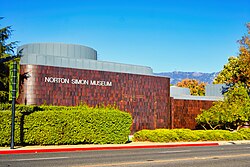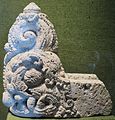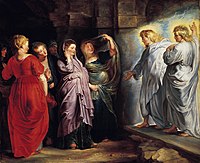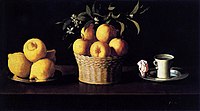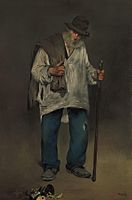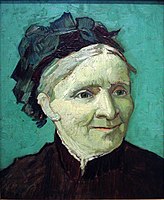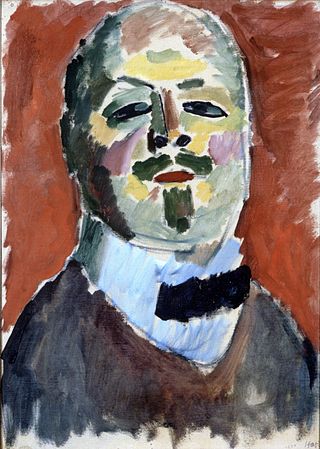
Alexej Georgewitsch von Jawlensky, surname also spelt as Yavlensky, was a Russian expressionist painter active in Germany. He was a key member of the New Munich Artist's Association, Der Blaue Reiter group and later the Die Blaue Vier.
The Huntington Library, Art Museum and Botanical Gardens, known as The Huntington, is a collections-based educational and research institution established by Henry E. Huntington and Arabella Huntington in San Marino, California. In addition to the library, the institution houses an extensive art collection with a focus on 18th and 19th century European art and 17th to mid-20th century American art. The property also has approximately 120 acres (49 ha) of specialized botanical landscaped gardens, including the "Japanese Garden", the "Desert Garden", and the "Chinese Garden".

The Los Angeles County Museum of Art (LACMA) is an art museum located on Wilshire Boulevard in the Miracle Mile vicinity of Los Angeles. LACMA is on Museum Row, adjacent to the La Brea Tar Pits.

The Museum of Contemporary Art, Los Angeles (MOCA) is a contemporary art museum with two locations in greater Los Angeles, California. The main branch is located on Grand Avenue in Downtown Los Angeles, near the Walt Disney Concert Hall. MOCA's original space, initially intended as a temporary exhibit space while the main facility was built, is now known as the Geffen Contemporary, in the Little Tokyo district of downtown Los Angeles. Between 2000 and 2019, it operated a satellite facility at the Pacific Design Center facility in West Hollywood.

The Hammer Museum, which is affiliated with the University of California, Los Angeles, is an art museum and cultural center known for its artist-centric and progressive array of exhibitions and public programs. Founded in 1990 by the entrepreneur-industrialist Armand Hammer to house his personal art collection, the museum has since expanded its scope to become "the hippest and most culturally relevant institution in town." Particularly important among the museum's critically acclaimed exhibitions are presentations of both historically overlooked and emerging contemporary artists. The Hammer Museum also hosts over 300 programs throughout the year, from lectures, symposia, and readings to concerts and film screenings. As of February 2014, the museum's collections, exhibitions, and programs are completely free to all visitors.

The Burghers of Calais is a sculpture by Auguste Rodin in twelve original castings and numerous copies. It commemorates an event during the Hundred Years' War, when Calais, a French port on the English Channel, surrendered to the English after an eleven-month siege. The city commissioned Rodin to create the sculpture in 1884 and the work was completed in 1889.

Norton Winfred Simon was an American industrialist and philanthropist. He was at one time one of the wealthiest men in America. At the time of his death, he had amassed a net worth of nearly US$10 billion.

The Thyssen-Bornemisza National Museum, or simply the Thyssen, is an art museum in Madrid, Spain, located near the Prado Museum on one of the city's main boulevards. It is known as part of the "Golden Triangle of Art", which also includes the Prado and the Reina Sofía national galleries. The Thyssen-Bornemisza fills the historical gaps in its counterparts' collections: in the Prado's case this includes Italian primitives and works from the English, Dutch and German schools, while in the case of the Reina Sofía it concerns Impressionists, Expressionists, and European and American paintings from the 20th century.
John Mason was an American artist who did experimental work with ceramics. Mason's work focused on exploring the physical properties of clay and its "extreme plasticity". One of a group of artists who had studied under the pioneering ceramicist Peter Voulkos, he created wall reliefs and expressionistic sculptures, often on a monumental scale.
Larry Bell is an American contemporary artist and sculptor. He is best known for his glass boxes and large-scaled illusionistic sculptures. He is a grant recipient from, among others, the National Endowment for the Arts and the Guggenheim Foundation, and his artworks are found in the collections of many major cultural institutions. He lives and works in Taos, New Mexico, and maintains a studio in Venice, California.
Walter "Chico" Hopps was an American museum director, gallerist, and curator of contemporary art. Hopps helped bring Los Angeles post-war artists to prominence during the 1960s, and later went on to redefine practices of curatorial installation internationally. He is known for contributing decisively to “the emergence of the museum as a place to show new art.”
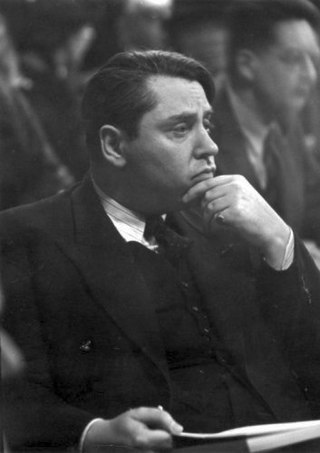
Jacques Goudstikker was a Jewish Dutch art dealer who fled the Netherlands when it was invaded by Nazi Germany during World War II, leaving three furnished properties and an extensive and significant art collection including over 1200 paintings, many of which had been previously catalogued as "Old Masters". The entire collection, which had been surveyed by Hermann Goering himself, was subsequently looted by the Nazis. Between the two World Wars, Jacques Goudstikker had been the most important Dutch dealer of Old Master paintings, according to Peter C. Sutton, executive director and CEO of the Bruce Museum of Arts and Science. Despite efforts of Goudstikker's widow after the war to regain possession of the collection, it was not until after her death that the Dutch government finally restituted 202 paintings to the Goudstikker family in 2006. To finance efforts to reclaim more of the stolen art, a large portion of them were sold at auction in 2007 for almost $10 million.
Ed Moses was an American artist based in Los Angeles and a central figure of postwar West Coast art.

Fourteen Rembrandt paintings are held in collections in Southern California. This accumulation began with J. Paul Getty's purchase of the Portrait of Marten Looten in 1938, and is now the third-largest concentration of Rembrandt paintings in the United States. Portrait of Marten Looten is now housed at the Los Angeles County Museum of Art (LACMA).
The Frederick R. Weisman Art Foundation is a non-profit arts foundation located on North Carolwood Drive in the Holmby Hills district of Los Angeles, California. Modern and contemporary artwork in the Frederick R. Weisman collection are displayed in a "living with art—house museum" context, with guided public tours by appointment with the foundation.

Galka Scheyer was a German-American painter, art dealer, art collector, and teacher. She was the founder of the "Blue Four," an artists' group that consisted of Lyonel Feininger, Wassily Kandinsky, Paul Klee and Alexej von Jawlensky.

Suzanne Muchnic is an art writer who was a staff art reporter and art critic at the Los Angeles Times for 31 years. She has also written books on artists, collectors, and museums.
Pratapaditya Pal is an Indian scholar of Southeast Asian and Himalayan art and culture, specializing particularly in the history of art of India, Nepal and Tibet. He has served as a curator of South Asian art at several prominent US museums including Boston's Museum of Fine Arts, the Los Angeles County Museum of Art, and the Art Institute of Chicago, where he has organized more than 22 major exhibitions and helped build the museums' collection. He has also written over 60 books and catalogs, and over 250 articles on the subject, taught at several universities, and served as the editor of the Indian art magazine, Marg. In 2009 he was awarded Padma Shri by the Government of India for his contributions to the study of Indian art.

Norman Charles Zammitt was an American artist in Southern California who was at the leading edge of the Light and Space Movement, pioneering with his transparent sculptures in the early 1960s, followed in the 1970s by his large scale luminous color paintings.
Isabel Wünsche is a German art historian and Professor of Art and Art History at Jacobs University Bremen.
